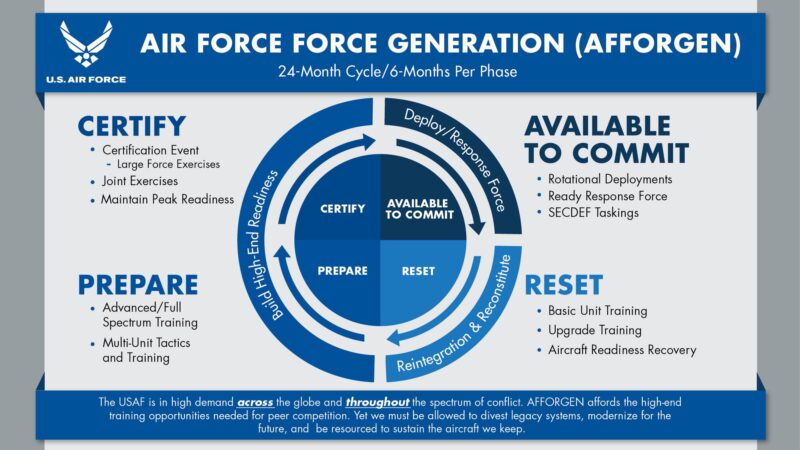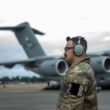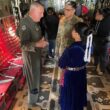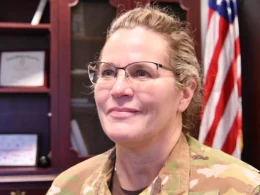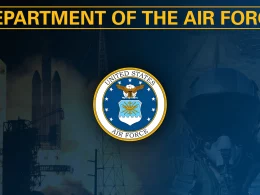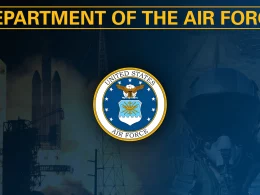ARLINGTON, Va. (AFNS) —
Big changes are underway for deployed Airmen as the U.S. Air Force transitions away from the expeditionary Air Force model of force presentation to the Air Force Force Generation model after more than 20 years of contingency operations.
What you need to know:
- The Air Force is changing the way it presents and generates forces for the first time in more than 20 years.
- The changes are designed to improve Air Force readiness for the high-end fight and to better communicate the capabilities that the service can provide to the Joint Force.
- All Airmen, except those assigned to joint positions, will be assigned to one of four phases that deploy on a 24-month cycle, or possibly more frequently for units assigned to the air component to a Combatant Command.
- Implementation of the new Air Force Force Generation model will evolve over time.
This change establishes a more structured and predictable cycle to better prepare Airmen for distributed, high-end combat operations by allowing focused time for individual and unit training and certification. The model also seeks to give joint leaders a more accurate picture of Air Force readiness and how the service can better support joint operations while maintaining that readiness.
According to Air Force senior leaders, the Air Force remains unmatched in its ability to provide airpower anytime, anywhere, but the service is now adapting to changes in the strategic environment to continue to fly, fight and win. While today’s Airmen are used to operating from main operating bases in uncontested environments, future conflicts will present radically different challenges that make this heard-earned experience less applicable.
AFFORGEN and related concepts are some of the ways the Air Force is advancing its warfighter culture to ensure its ability to win tomorrow’s conflicts as part of the joint team.
“We have been able to get away with taking three Airmen from this base, five Airmen from this base, and two Airmen from that base, deploying them and expecting them to come together on day one and be a team,” said Lt. Gen. James Slife, headquarters Air Force deputy chief of staff for operations, during an AFFORGEN panel at the Air Warfare Symposium March 8. “We don’t actually think that’s the way the future operating environment is going to permit us to operate.”
Slife’s comments reinforced comments made by Air Force Chief of Staff Gen. CQ Brown, Jr., during his keynote address on the state of the Air Force during the September 2022 Air, Space and Cyber Conference.
“We need an approach that serves our national security and defense strategies, our joint warfighting concept and recognizes the changing threats and tendencies in the character of warfare,” Brown said, emphasizing the need to accelerate the adoption of new operational concepts. “Adoption is making the concepts part of our DNA, part of our culture.”
Brown considers AFFORGEN as one the drivers for culture change, particularly in the way the Air Force presents and deploys forces — others are agile combat employment, mission command, multi-capable Airmen and the wing A-staff construct.
Brown instituted his strategic approach of “Accelerate Change or Lose” when he became the Air Force’s Chief of Staff because he saw uncontested air dominance was not assured, and AFFORGEN, along with other drivers for change, are a way for the service to maintain its dominance in a changing operational environment.
AFFORGEN establishes a 24-month rotational cycle broken into four, six-month phases: Prepare, Certify, Available and Reset. Airmen and units build readiness through the prepare and certify phases, deploy during the available phase and reintegrate and reconstitute during the reset phase.
While Airmen in joint assignments do not typically support Air Force deployments, they could be tasked worldwide and should ensure they remain ready. Airmen assigned to the air components of combatant commands, such as Indo-Pacific Command or European Command, may deploy for operations and exercises within their specific CCMD’s area of responsibility. However, in some cases they may also be tasked to deploy outside of that AOR.
AFFORGEN will continue to evolve as Airmen deploy and provide lessons learned to their units. The Headquarters Air Force Lessons Learned Directorate, along with the Headquarters Air Force Directorate of Operations are the focal points for AFFORGEN-related lessons learned, studies, analyses, assessments, modeling, simulation and policy. In addition, the Air Force Expeditionary Center is responsible for developing a standardized way for commanders to coordinate training, share lessons and mentor their successors.
Force elements
Under AFFORGEN, the Air Force presents capabilities as force elements made up of multiple unit type codes. Each type of FE provides a specific operational capability:
- Mission Generation: Provides combat, combat support (those that are specifically identified on the aviation/operational UTC’s mission capability statement) and combat service support capability. There are multiple types of MG FEs: Mobility, Air Superiority, Global Precision Attack, Suppression of Enemy Air Defenses, Long Range Strike, High-Altitude Intelligence, Surveillance, and Reconnaissance, Air Refueling, Intra-Theater Airlift and Combat Search and Rescue.
- Open the Airbase: This FE provides capabilities to open an airbase, regardless of follow-on mission(s), including command and control, force protection, cargo and passenger handling, logistics, airfield operations, force accountability, finance and contracting, host nation support, reception and bed-down of follow on forces.
- Command and Control: This FE provides the capabilities to establish an Air Expeditionary Wing C2 structure and includes initial wing operations, maintenance, mission support and medical group commanders as well as the Air (A) and special staffs.
- Establish the Airbase: This FE provides sufficient forces to support most missions or weapon systems. It integrates with the Open the Air base and C2 FEs as required and provides the earliest capability to enable and sustain the generation of missions.
- Operate the Airbase: This FE enhances combat support and combat services support capabilities beyond what the Establish the Airbase FE provides and brings it to full operational capability.
- Robust the Airbase: This FE provides additional combat support and combat service support to increase the robustness of the capabilities already in place.
- Demand Force Teams: DFTs are units or capabilities with unique or highly specific combat, combat support, or combat service support capabilities. Examples include the Expeditionary Medical Support System, Rapid Engineering Deployable Heavy Operations Repair Squadron – Engineer, or Combat Camera squadrons.
In addition to being part of an FE, USAF-funded active-duty Airmen are assigned to deployment phases A, B, C, or D, which replace the previous P-and X-bands. Airmen will begin deploying under AFFORGEN in October, with phase C followed by D, A, and B phases every six months. These phases then repeat every 24-months.
AFFORGEN FEs are intended to be tailorable but not divisible. This means if a joint force commander only requests a specific subset of UTCs from a FE, the remaining UTCs will remain unavailable for use during that AFFORGEN cycle.




